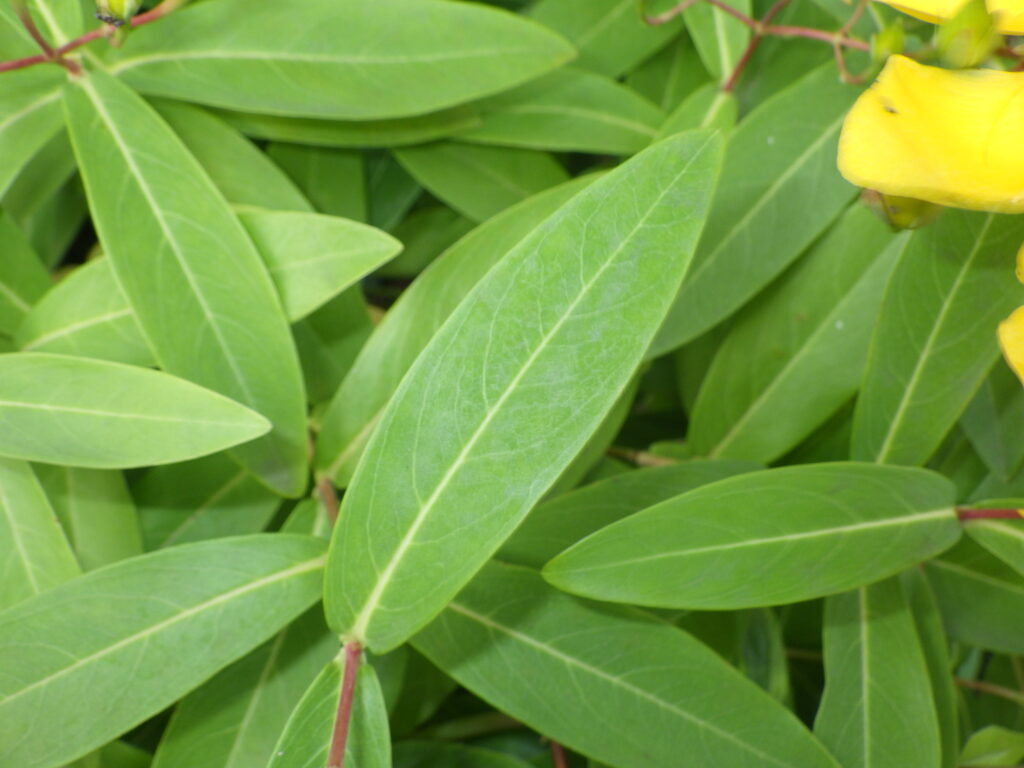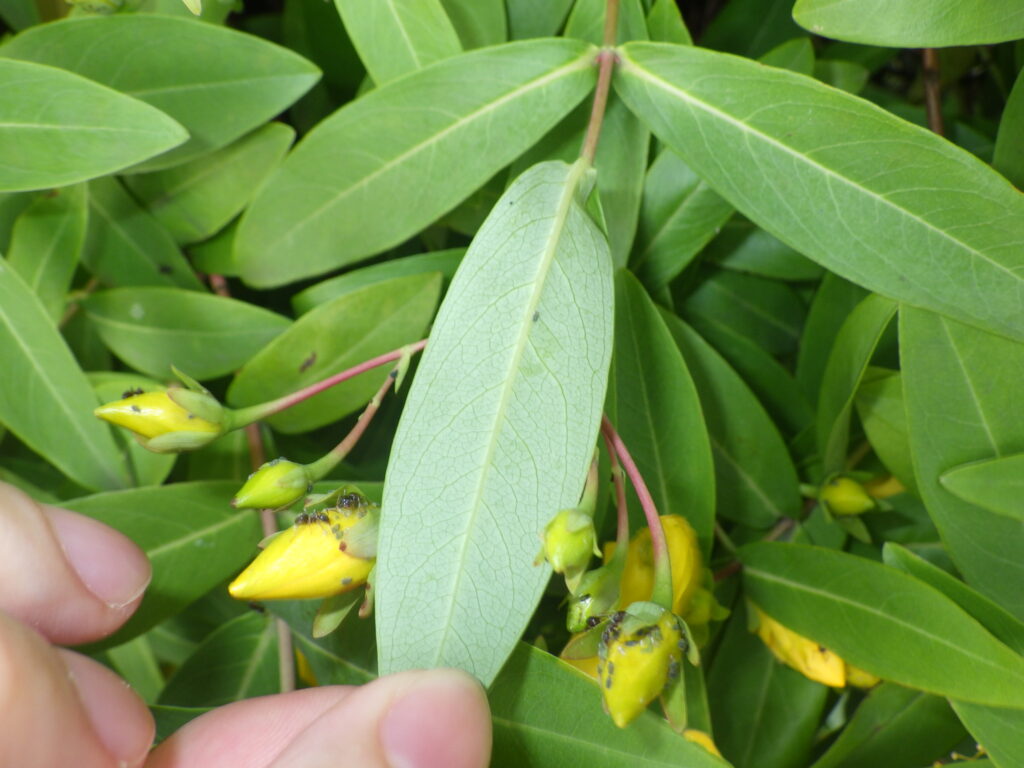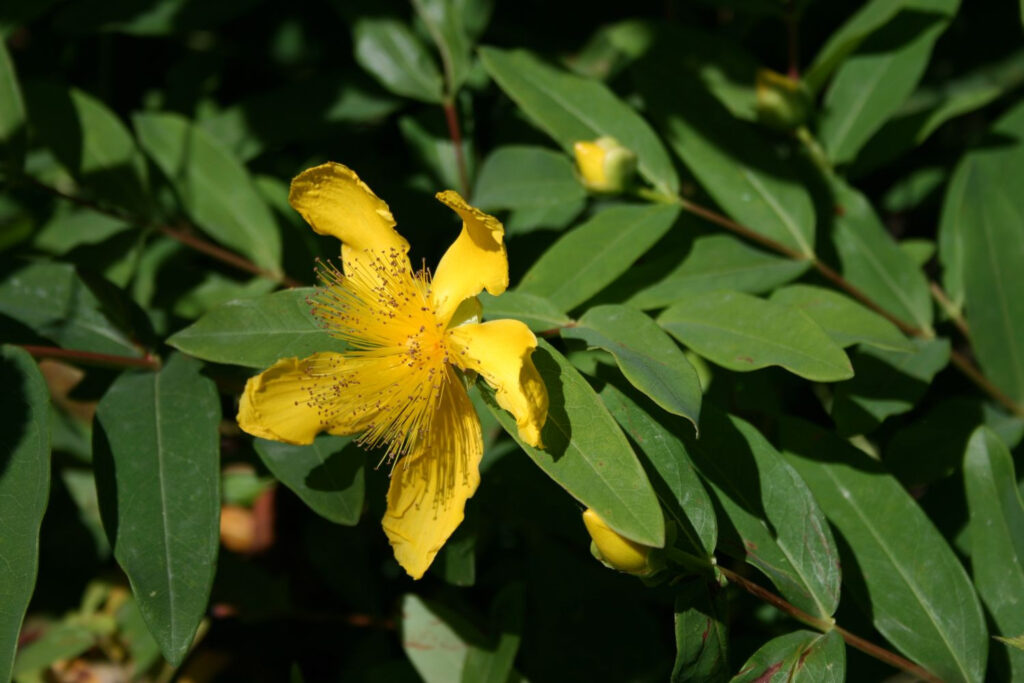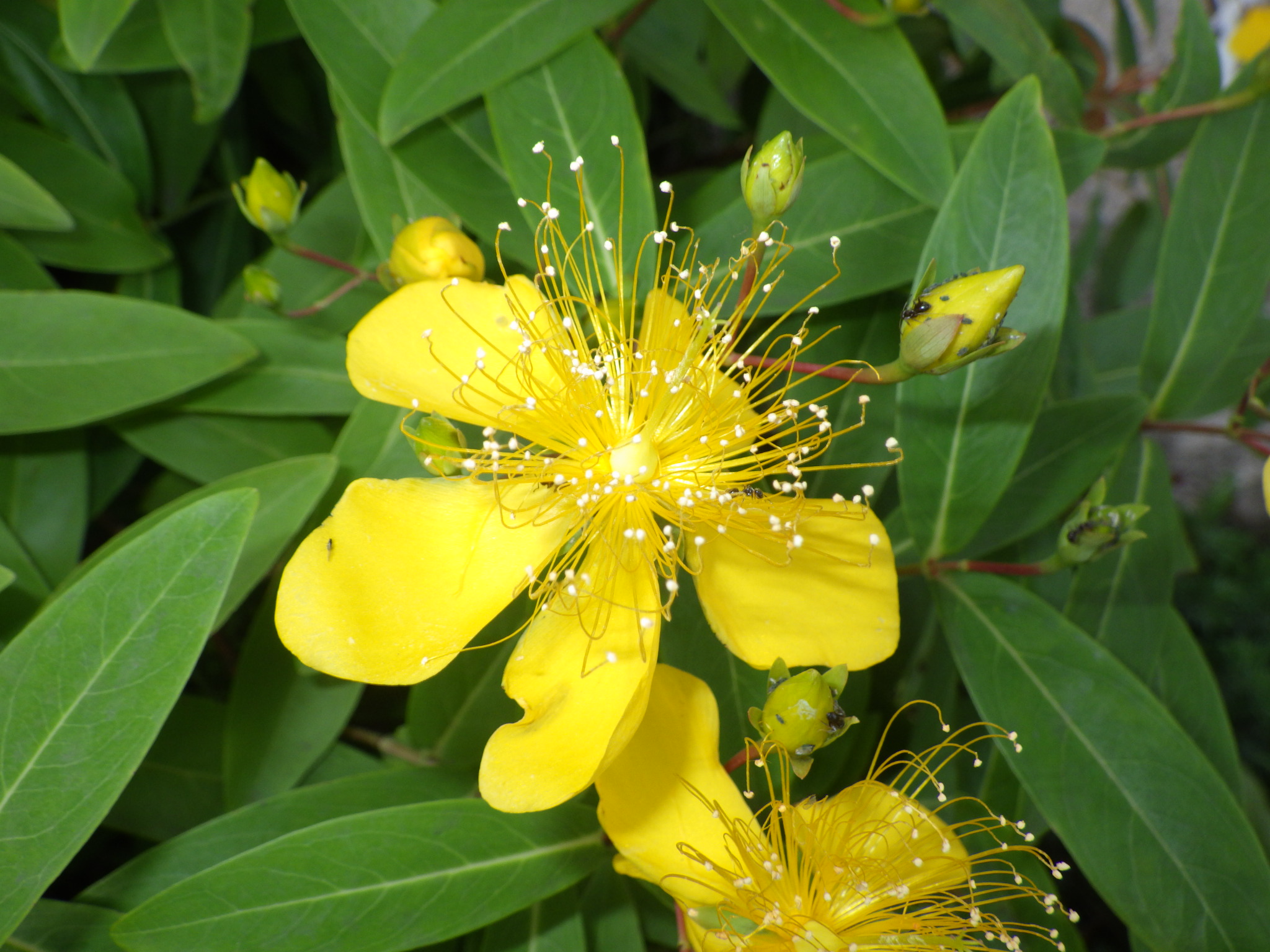キンシバイ・ビヨウヤナギ・タイリンキンシバイ(ヒドコート)・セイヨウキンシバイはいずれもオトギリソウ科オトギリソウ属で、日本では観賞用に栽培される常緑小低木です。町中では頻繁に見かけ、黄色い花をつける種類としてとても人気がありますが、その区別はパッと見は難しいです。特にキンシバイとタイリンキンシバイは混同されます。しかし、これら4種には明確な違いがあり、葉と花をよく観察することで区別することができます。花弁は5個で、黄色の花には研究不足ですが、ハナバチ類、特にミツバチが好んで訪れるものと思われます。シンプルな花にも思えますが紫外線を反射することで訪花昆虫には異なった色合いに見えています。果実は蒴果で種子は重力散布と風散布によって分散するものと思われます。本記事ではキンシバイ・ビヨウヤナギ・タイリンキンシバイ・セイヨウキンシバイの分類・形態・送粉生態・種子散布について解説していきます。
キンシバイ・ビヨウヤナギ・タイリンキンシバイ(ヒドコート)・セイヨウキンシバイとは?
キンシバイ(金糸梅) Hypericum patulum は中国四川省原産で、開けた森や藪、渓谷の崖、道端に生える常緑小低木です(Wu et al., 2007)。現在では中国南西部・日本・インド・南アフリカで広く観賞用に栽培されて一部野生化しています。日本の本州・四国・九州では里に近い山間渓流地などの湿った岩場に野生化していることもあります。「金糸梅」という和名は雄しべが金の糸のように見え、梅の花に似ているとされたことに由来します。
ビヨウヤナギ(未央柳・美容柳) Hypericum monogynum は中国南西部・台湾原産で、山の斜面、道端、乾燥した藪に生える常緑小低木です(Wu et al., 2007)。現在では日本・南アフリカ・東アジア・南アジア・オーストラリア・中央アメリカ・北ヨーロッパ・西ヨーロッパ・モーリシャス・西インド諸島で広く観賞用に栽培されており、日本では稀に野生化します。
セイヨウキンシバイ(西洋金糸梅) Hypericum calycinum はブルガリア・トルコ原産で、荒地、道路沿いの土手、開けた丘の中腹、砂利の浜辺に生える匍匐性の常緑小低木です(RBG Kew, 2023)。現在では日本・ヨーロッパ・コーカサス・ニュージランドで栽培され、一部野生化しています。
タイリンキンシバイ(大輪金糸梅) Hypericum x hidcoteense は別名ヒペリカム・ヒドコート。セイヨウキンシバイと H. x cyathiflorum の人工交雑による雑種の常緑小低木です(Maggi et al., 2008)。H. x cyathiflorum はヒマラヤキンシバイ H. hookerianum・H. addingtonii の人工交雑による雑種です。日本では観賞用に頻繁に栽培されています。学名は Hypericum ‘Hidcote’ とも日本ではされますが、『Plants of the World Online』では上記の学名が採用されているのでここではこれに従います(RBG Kew, 2023)。また、Hypericum patulum ‘Hidcote’ ともされてきましたが、これはキンシバイの園芸品種ではないので明らかな間違いと考えられます。更に別名ですが、学名はラテン語なので読みは「ヒペリクム・ヒドコート」が本来正確ですが、ヒペリカム・ヒドコートが定着してしまっています。「ヒデコート」という表記もあります。以下ではややこしいのでタイリンキンシバイで呼んでいきます。タイリンは漢字で「大輪」で大きな花を意味します。
いずれもオトギリソウ科オトギリソウ属で、日本では観賞用に栽培される常緑小低木です。町中では頻繁に見かけ、葉が対生・全縁で葉柄は殆ど無く、黄色い花をつける種類としてとても人気がありますが、その区別はパッと見は難しいです。特にキンシバイとタイリンキンシバイは上述のように、かつて「タイリンキンシバイはキンシバイである。」とされてきたことから同一視され、現在でも間違った記述を行うサイトが散見されます。
セイヨウキンシバイについても比較的レアであることから、花の形が似ているビヨウヤナギと混同されて、見過ごされていることはあるでしょう。
キンシバイ・ビヨウヤナギ・タイリンキンシバイ(ヒドコート)・セイヨウキンシバイの違いは?
しかし、これら4種には明確な違いがあります(Wu et al., 2007; Heenan, 2014; 神奈川県植物誌調査会,2018;林,2019)。まず、葉について注目してみます。
キンシバイでは葉は平面的につき、下面は粉白色が多く葉脈が殆ど見えないのに対して、他のビヨウヤナギ・セイヨウキンシバイ・タイリンキンシバイでは葉は節ごとに角度がずれてつき、下面は粉白色はあるものの葉脈は見えるという違いがあります。
残りの3種に関しては、ビヨウヤナギでは葉が楕円形~披針形で、葉先が比較的やや尖るのに対して、セイヨウキンシバイ・タイリンキンシバイでは惰円形~卵形で、葉先が比較的丸いという違いがあります。
セイヨウキンシバイとタイリンキンシバイに関しては、セイヨウキンシバイでは葉縁に特別な色はなく、葉脈は細かい側脈まではっきり見えるのに対して、タイリンキンシバイでは葉縁が赤く、葉脈は側脈は見えるものの細かい部分は見えないという違いがあります。
葉にも特徴は出ていますが、葉だけで区別するのはもしかすると難しいかもしれません。花にも違いがあります。
キンシバイとタイリンキンシバイでは雄しべが9mm以下と明らかに短いのに対して、ビヨウヤナギとセイヨウキンシバイでは雄しべが17~30mmと明らかに長いです。
キンシバイとタイリンキンシバイに関しては、キンシバイでは花弁は小さく切れ込みはなく、カップ状になり完全に開ききらないのに対して、タイリンキンシバイでは花弁は大きく切れ込みがあり、平面状に開ききるという違いがあります。
ビヨウヤナギとセイヨウキンシバイに関しては、ビヨウヤナギでは雄しべの葯(花粉を出す先端部分)が黄色であるのに対して、セイヨウキンシバイでは葯がオレンジ色~赤色という違いがあります。
以上で必ず区別できると思います。










他に似た種類はいる?
キンシバイとバラ科のヤマブキの違いについてもよく検索されているようです。この違いについては別記事を御覧ください。
花の構造は?
オトギリソウ属では共通で集散花序につき、萼は深く5裂し、花弁は5個で、黄色で互いに重なります。ここであげた4種はオトギリソウ属の中でも特に花冠が大きいです。
キンシバイは花期が5~7月。花序に花は1~15個つきます。花柄は長さ2~4(~7)mm。花は直径2.5~4cm、深いカップ形。萼片は長さ5~10mm。花弁は長さ1.2~1.8cm、幅1~1.4cm、萼片の長さの1.5~2倍。雄しべは50~70個が束になり、長いものは7~12mm、花弁の0.4~0.5倍の長さ。子房は長さ5~6mm、幅3.5~4mm。花柱は長さ4~5.5mm、子房の0.75~0.95倍の長さ。
ビヨウヤナギは花期が5~7月。花序は1~15(~30)個の花がつきます。花柄は長さ0.8~2.8(~5)cm。花は直径3~6.5cm。萼片は長さ4.5~13mm、幅1.5~6mm。花弁は黄金色~レモン色、長さ2~3.4cm、幅1~2cm、萼片の長さの2.5~4.5倍、全縁、腺点はありません。雄しべは5個の束になり、それぞれ25~35個の雄しべがあります。雄しべは花弁より長く、長い雄しべは長さ1.8~3.2cm。 子房は長さ2.5~5mm、幅2.5~3mm。花柱は長さ1.2~2cm、子房の長さの3.5~5倍。
セイヨウキンシバイは花期が6~7月。花弁は5個、長さ25~40mm。広角に開きます。雄しべは束ごとに90~120個、花弁より長く、目立ちます。葯は赤色を帯びます。花柱は長さ12~20mm。
タイリンキンシバイは花期が5~7月。花弁は広角に開き、ほぼ平開し、普通、先が浅く切れ込みます。雄しべは多数つき、花弁の長さの1/2より短いです。
受粉方法は?
黄色く目立つ花は明らかに虫媒花ですが、これら4種の具体的な訪花昆虫の研究は少ないです。
キンシバイでの研究は発見できませんでした。
ビヨウヤナギでは奈良県で行われた研究によると10分の間にニホンミツバチが25個体、セイヨウミツバチが3個体訪れた記録があります(Tatsuno & Osawa, 2016)。しかし、ビヨウヤナギに訪れる昆虫を全て記録した研究ではないため、ミツバチしかやってこないのかは分かりません。ただミツバチに人気であるとは言えそうです。
タイリンキンシバイでは奈良県で行われた研究では90%以上がハナバチ類で、わずかにハナアブ類がやってくるという結果でした(横井ら,2008)。また宮城県で行われた研究では定性的ですがセイヨウミツバチが訪れた記録があります(藤原・山口,2020)。なお、これらの研究では「キンシバイ」という表記でしたが、おそらくタイリンキンシバイを指していると思われます。
セイヨウキンシバイでも訪花昆虫を直接観察した研究は発見できませんでしたが、関連する研究があります(Gronquist et al., 2001)。
セイヨウキンシバイの花は、人間には一様に黄色に見えますが、ミツバチなどの訪花昆虫には見える「紫外線色」を持っており、昆虫には見え方が異なります。
この「紫外線色」はフラボノイドと脱芳香族化イソプレニル化フロログルシノール(DIP)という2つの色素によって作り出されています。フラボノイドは花弁での紫外線色素として機能しますが、DIPは花の葯と子房壁で高濃度で存在し、訪花昆虫を引き寄せるとともに、実験内では蛾の一種であるベニゴマダラヒトリの近縁種 Utetheisa ornatrix の幼虫(毛虫)に対して抵抗性と毒性を持ち、防御機能があることが分かっています。
2つの機能を兼ね備えているという点で興味深いですが、現状他のオトギリソウ属でも同じ物質が存在しているかは分かっていません。セイヨウキンシバイにもミツバチが訪れる可能性は高そうですが、やはり訪花昆虫全体での個体数の割合は不明です。
総合するとハナバチ類、特にミツバチが好むと言えそうですが、これからの研究に期待したいところです。
果実の構造は?
キンシバイ科の果実は通常蒴果です。蒴果は乾いた果実(乾果)の一種で、一つの果実が複数の癒着した袋状果皮からなります。
キンシバイの蒴果は長さ0.9~1.1cm、幅8~10mm。 種子は長さ1~1.2mm、暗褐色。
ビヨウヤナギの蒴果は長さ6~10mm、幅4~7mm。種子は暗赤褐色、長さ約2mm。
セイヨウキンシバイの蒴果は長さ10~20mm、卵形。種子は赤褐色、長さ1.5~2mm、表面の一部が網状になります。
タイリンキンシバイの蒴果は長さ約1cm。
種子散布方法は?
蒴果は熟すると乾燥して内部から種子を零します。重力散布は少なくともされますが、種子は非常に小さいので、おそらく風散布も頻繁に起こっていると思われますが研究はありません。
ただし他のオトギリソウ属の研究として、セイヨウオトギリ H. perforatum ではほとんどの種子が親株の近くに落ち、風による最大飛散距離は年間10m程度という予測があります(Harris & Gill, 1997)。 H. canariense・H. balearicum も風散布とされます(Seguí et al., 2021; Afonso et al., 2022)。
引用文献
Afonso, L., Esler, K., Gaertner, M., & Geerts, S. 2022. The invasive alien Hypericum canariense in South Africa: Management, cost, and eradication feasibility. South African Journal of Botany 146: 685-694. https://doi.org/10.1016/j.sajb.2021.11.032
藤原愛弓・山口喜久二. 2020. 宮城学院女子大学における開花植物の季節的推移―大学構内におけるミツバチの蜜・花粉源植物の調査―. 生活環境科学研究所研究報告 52: 19-24. ISSN: 1346-6534, https://doi.org/10.20641/00000488
Gronquist, M., Bezzerides, A., Attygalle, A., Meinwald, J., Eisner, M., & Eisner, T. 2001. Attractive and defensive functions of the ultraviolet pigments of a flower (Hypericum calycinum). Proceedings of the National Academy of Sciences 98(24): 13745-13750. https://doi.org/10.1073/pnas.231471698
Harris, J. A., & Gill, A. M. 1997. History of the introduction and spread of St. John’s wort (Hypericum perforatum L.) in Australia. Plant Protection Quarterly 12(2): 52-56. https://caws.org.nz/PPQ1112/PPQ%2012-2%20pp052-56%20Harris.pdf
林将之. 2019. 増補改訂 樹木の葉 実物スキャンで見分ける1300種類. 山と溪谷社, 東京. 824pp. ISBN: 9784635070447
Heenan, P. B. 2014. Flora of New Zealand Seed Plants: Hypericaceae. Manaaki Whenua Press, Lincoln. 53pp. ISBN: 9780478347630, https://doi.org/10.7931/J2MW2F2B, https://www.nzflora.info/factsheet/taxon/Hypericum-calycinum.html
神奈川県植物誌調査会. 2018. 神奈川県植物誌2018 電子版. 神奈川県植物誌調査会, 小田原. 1803pp. ISBN: 9784991053726
Maggi, F., Tirillini, B., Vittori, S., Sagratini, G., Ricciutelli, M., & Papa, F. 2008. Essential oil composition of Hypericum ‘Hidcote’. Journal of Essential Oil Research 20(6): 539-541. https://doi.org/10.1080/10412905.2008.9700083
RBG Kew. 2023. The International Plant Names Index and World Checklist of Vascular Plants. Plants of the World Online. http://www.ipni.org and https://powo.science.kew.org/
Seguí, N., Jiménez, M. A., & Cursach, J. 2021. Local conditions effects on seed germination of Hypericum balearicum L. in response to temperature. Flora 282: 151896. https://doi.org/10.1016/j.flora.2021.151896
Tatsuno, M., & Osawa, N. 2016. Flower visitation patterns of the coexisting honey bees Apis cerana japonica and Apis mellifera (Hymenoptera: Apidae). Entomological Science 19(3): 255-267. https://doi.org/10.1111/ens.12206
横井智之・波部彰布・香取郁夫・桜谷保之. 2008. 近畿大学奈良キャンパスにおける訪花昆虫群集の多様性. 近畿大学農学部紀要 41: 77-94. ISSN: 0453-8889, http://id.nii.ac.jp/1391/00005214/
Wu, Z. Y., Raven, P. H. & Hong, D. Y. 2007. Flora of China. Vol. 13 (Clusiaceae through Araliaceae). Science Press, Beijing, and Missouri Botanical Garden Press, St. Louis. ISBN: 9781930723597



